A Flying Legacy – Asafo Warrior Flags
PRIMITIVE - Monday, October 05, 2015By Misaki Imagawa
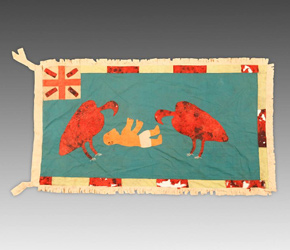 |
|
How much value is there in a piece of cloth? Consider an old bed sheet or a cheap store-bought scrap of fabric. No one would bat an eye if it was damaged, discarded, dragged through mud or used as a doormat. However, paint a country's flag upon it and set it on fire and, well, you can safely expect all hell to break loose. It's still the same piece of fabric, but now that fabric is charged with meaning. Such is the nature of flags.
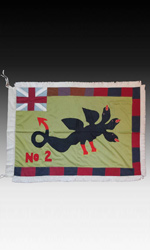 |
|
Flags were first used by knights in medieval times to identify their allegiance, but earlier predecessors such as banners and cloth-draped staffs called vexilloids reach far back into the ancient world. First and foremost, these types of identifying markers were utilized as a practical method of differentiating friend from foe during battle; however, they also collectively represented noble households, armies, and even empires. All were symbols of pride, dignity and loyalty, which they remain to this day by countries and organizations around the world.
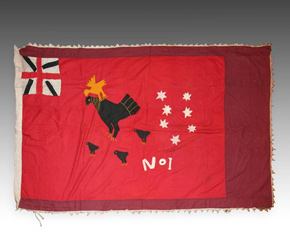 |
|
The use of flags was not limited to Europe and the Far East. Historical records indicate that cultures in present day Ghana and Mali in West Africa also utilized flags. Along the southern coast of Ghana, the use of flags flourished among the Fante people, part of the larger Akan group. Unlike the Asante, their rival neighbors, the Fante never formed a centralized kingdom. Each state was ruled instead by a paramount chief and protected by traditional warrior groups called Asafo that used flags extensively. Asafo flags are now a recognized collectible and highly valued in the world of African art.
Sa meaning 'war' and fo meaning 'people,' the Asafo were aptly named military organizations; however, each Fante state had their own separate unit or 'company,' patterned after European military organizations. The primary function of the Asafo warrior groups was defense against hostile neighbors, but they also held considerable power within Fante society. Serving as a political counterbalance, the Asafo were responsible for the selection, enthronement – commonly known as ‘enstoolment’ – and occasionally even the ‘de-stoolment’ of chiefs. Asafo elders would also act as trusted advisors to the ruling elite.
 |
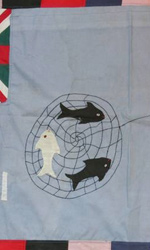 |
||
Historians agree the Asafo existed well before the Portuguese first landed on their shores in 1471, but much of their traditions were heavily influenced by the ensuing 500 years of contact with European military organizations. The African Gold Coast, a region well known for its abundant resources, was a natural attraction to many foreign powers that brought land and naval forces to procure and protect their investments. Marching processions, numbered companies, regimental colors and elaborate regalia all made an impact on the Fante and the rituals of the Asafo – but it was foreign flying banners and national flags that made the greatest impression.
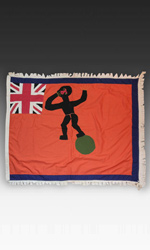 |
|
Each Asafo company identified itself with a distinct flag, called frankaa, which is simply the Fante word for flag. Along with the company's shrine, or fort-like base, the flag was the most important object to the organization. They were flown on tall masts at the shrine with great pride. The Asafo attributed to their flags the same honor and pride Europeans associated with their national flags. The highest responsibility of the Asafo was to protect their flag from being captured by an enemy or insulted. Historical accounts from the early 1600s suggest that prior to the use of frankaa by the Asafo, white flags or banners were already in use during important ceremonial events such as the enstoolment of a chief. However, by the late 17th century, each Asafo company was adorned with multiple, diverse flags boldly bearing their unit numbers. It was during this time that Asafo flags became imbued with great meaning.
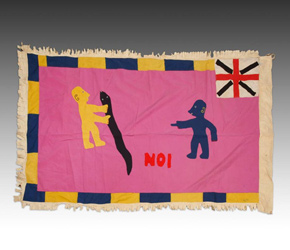 |
|
Although the customs and rituals surrounding flags were influenced by European contact, the designs were distinctly African – rich with symbolism. Some flags depicted historical themes or emblems such as warships, airplanes or stylized mythical creatures inspired by European heraldry. However, most were visual representations of age-old Fante proverbs. As in many tribal societies with no written language, the recitation of proverbs was a widely used method to teach traditions, beliefs and impart wisdom in regard to all aspects of daily life. In the Fante language there are thousands of proverbs, and many were depicted as imagery on the frankaa.
Due to their military nature, Asafo flags were often designed to emphasize power and prowess. Many of the flags in PRIMITIVE’s collection illustrate these concepts. Rivalries between states were inevitable, and sometimes this tension was triggered and aggravated by nothing more than individual flag designs. For example, a flag featuring a lion and leopard reflected the popular proverb: "A dead lion is greater than a living leopard." It meant a Fante state at its worst was still stronger than its rival. Flags with snake motifs warned enemies, "We're too dangerous for you to handle." Another design depicted a child beneath a pepper tree. The proverb here: "If the child wants to pick a ripe pepper, let him; when it gets into his eyes he will stop himself." It implies that rival companies are like impertinent and inexperienced children, who can only learn the hard way.
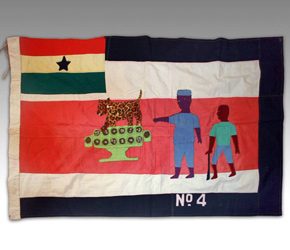 |
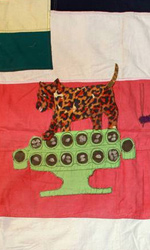 |
||
A single Asafo company possessed multiple flag designs, as new ones would often be commissioned when a new captain was elected. In the past, some flags were meant as deliberate insults to other units and when they were flown, war ensued. The same occurred when one company used the artistic prerogatives of another company's colors, emblems and patterns – it was the Fante equivalent of throwing down the gauntlet. By the late 19th century, strict rules were established by each state that dictated new flags must be approved by multiple parties, both military and political, before becoming official. This resulted in an unusual characteristic of Asafo flags from this time period – the inclusion of the British Union Jack in the upper corner of the flags.
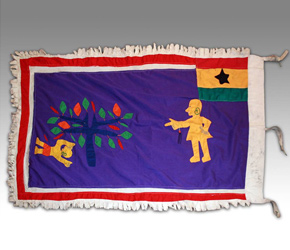 |
|
In the 19th century the British first established the Fante lands as a protectorate and later a colony, becoming entrenched in its economic and military affairs and in particular providing protection against invasions from the neighboring Ashanti to the north. The appearance of the Union Jack on Asafo flags symbolized the colonial alliance that existed between the British and the Fante. It was also a way for the Fante to show respect for the British colonizers, especially their military strength. In addition, the inclusion of the Union Jack could also be construed as a stamp of approval by the British for a particular flag; however, it can be argued some of the proverbs appearing on these flags were meant to mock, rather than honor the colonizers. For example, one flag in PRIMITIVE’s collection depicts the proverb, “The enemies we confront are vultures.” This proverb could just as easily apply to the British – and most likely did – as any neighboring state. Another flag from the collection appears to illustrate the proverb, “When the cock is drunk he forgets about the hawk.” Did this suggest a subtle message for the British to beware? Today, collectors use the appearance of the Union Jack on Asafo flags to determine the era they were created, for this purely British symbol ceased being used after Ghanaian independence in 1957. Most of the flags in PRIMITIVE's extensive collection were made during the British colonial era and show the Union Jack in the upper corners. Flags made after the colonial era show the Ghanaian national flag.
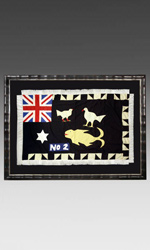 |
|
Although the British colonizers, and later the Ghanaian government, attempted to curb the military nature of the Asafo, the warriors protected their traditions just as ardently as their flags. However, their role in society did change over the years. Today, Asafo companies can mostly be seen leading festivals and celebrations and flying their colors in annual parades. Warfare with neighboring tribes and villages is a thing of the past; so now the flags may be used by trained members of the Asafo in spectacular dances re-enacting historical scenes of battle and leadership or hung around Asafo shrines. The flags remain proud reminders of the Asafo warrior’s legacy of pride, honor and courage as they fly high above the collecting world.
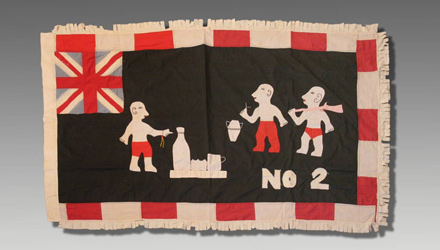 |
Download this Article: A Flying Legacy.pdf